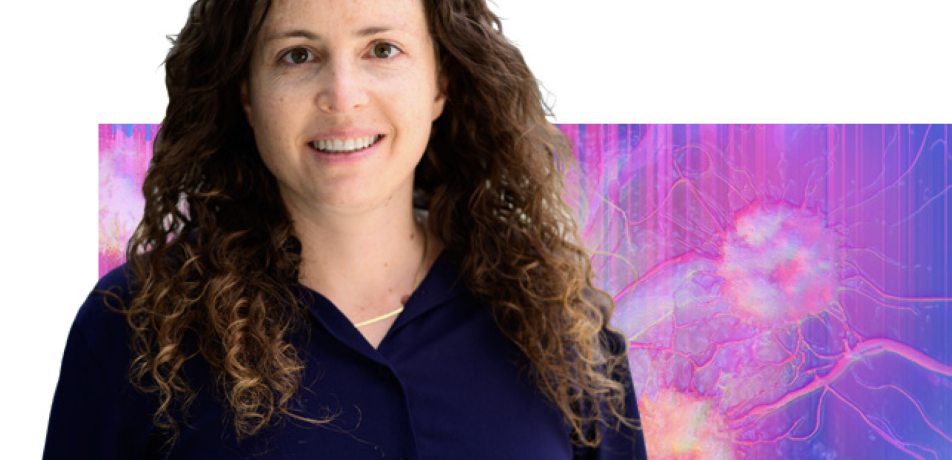Behind every great neuron is a gallant glia cell
Dr. Tal Iram
New scientists

Like indispensable servants standing silently beside gilded aristocrats, glia cells support and influence the function of neurons in largely underappreciated ways. Dr. Tal Iram is among those neuroscientists working to reveal how glia cells drive the learning and memory encoding of their more glamorous partners, neurons. The health or dysfunction of one type of glia cell—oligodendrocytes—may hold the key to brain aging and rejuvenation, she contends.
Oligodendrocytes (OLs) mainly provide support and insulation, or myelin, to brain and spinal cord axons—the long extensions by which neurons send each other messages via electrical impulses. Insulating myelin is vital to neuron survival: in a complex chain of events, OLs form myelin segments for the exact appropriate zone of the axon, guide these segments as they sheath the axon, and extend myelin segments to their proper lengths.
The intricate structure of myelin continues to evolve throughout the first five decades (yes, decades) of a person’s life, regulating the timing and synchronization of the neuronal network. But there’s more.
In a series of headline-making studies conducted during her postdoctoral fellowship at Stanford University in the lab of Prof. Tony Wyss-Coray, Dr. Iram demonstrated that an infusion of cerebrospinal fluid (CSF) from young mice to aged mice boosted the production of progenitor cells that develop into OLs (“OL progenitor cells” or OPCs)—and boosted memory.
Using sophisticated sequencing, she isolated the key actors behind CSF’s elixir-like properties: young CSF contains higher levels of two proteins: a fibroblast growth factor (FGF-17) and a serum response factor (SRF). FGFs boost cell survival and are involved in multiple biological processes. SRF is a transcription factor that promotes the production of proteins involved in embryonic development, among other things. And somehow, the combination of FGF-17 and SRF in young CSF can turn back time.
Dr. Iram and Prof. Wyss-Coray have filed a patent application for the use of FGF-17 to rejuvenate OLs and
target aging-related memory loss as a first step toward translating their findings to the clinic.
Obtaining youthful mouse CSF and infusing it into aging mouse brains, however, is no mean feat. In fact, it was an approach rarely tried due to the extreme technological challenges involved. Dr. Iram worked for over a year and a half to perfect her approach.
Biomarkers of integrity
At the Weizmann Institute, Dr. Iram plans to further her efforts to showcase the as-yet unsung praises of glia. Her lab will strive to advance our understanding of OL plasticity in learning and memory and connect this to cognitive decline in aging and neurodegenerative diseases like Alzheimer’s disease.
Building off her work on the FGF17-SRF connection in cerebrospinal fluid, she will focus on how these factors affect OL cell biology and develop tools to identify novel biomarkers of OL integrity.
As Dr. Iram notes, by the time neurodegenerative disease has caused detectable damage to neurons, there is little if anything that can be done to reverse it. By contrast, glial dysfunction happens sooner in the course of disease and, as she has shown, may be far more amenable to treatment.
Harnessing this plasticity of glia cells presents a window of opportunity for much earlier and more effective intervention against neurodegeneration.
“By first understanding and then targeting oligodendrocytes early on, before neuron loss, we may be able to extend the period of healthy brain function as we age,” says Dr. Iram.
Stopping to pick the oranges
Recalling a summer when she worked as an undergraduate student in the Weizmann Institute lab of Prof. Oren Schuldiner, Dr. Iram warmly remembers the lab members taking a break from their research on developmental neuroscience to pick oranges on campus.
She is now thrilled to be joining the faculty in September 2024, as the first official hire of Weizmann’s new Department of Molecular Neuroscience. She is especially excited about the opportunities and collaborations that await her as part of the neuroscience flagship, the Azrieli Institute for Brain and Neural Sciences, and in the new, state-of-the-art building that will house this ambitious flagship initiative.
Dr. Iram is passionate about science education. In 2014, she founded the first annual national Brain Bee in Israel—a neuroscience competition for high school students.
She is married with three children.
Education and select awards
-
Israeli leadership program of Military Intelligence Unit 8200
-
BSc summa cum laude, Tel Aviv University (2009)
-
Direct-track PhD, Tel Aviv University (2017), conducted partly at Massachusetts General Hospital/Harvard University in Boston
-
Postdoc, Stanford University School of Medicine (2017-2022)
-
Clore Scholarship for Outstanding PhD students (2014); Israeli Postdoctoral Scholar, Zuckerman STEM Leadership Program (2017); Stanford University’s Sammy Kuo Award in Neuroscience (2022)
Appointments
-
Instructor, Stanford University (2022-2023)








